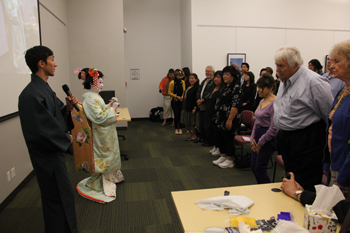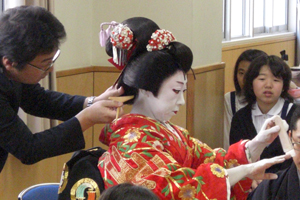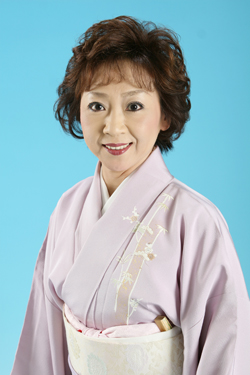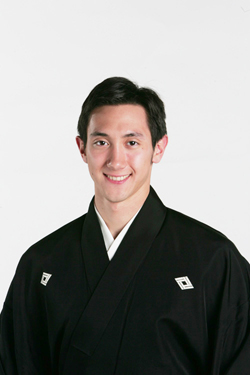

by Colin Marshall
 What Westerner has set eyes on a traditional kabuki or noh performer, or even a geisha, without wondering what it takes to achieve such a striking, iconic appearance? On the night of April 10th, well-known dancer and third-generation headmaster of Nagoya's Nishikawa Dance School Masako Nishikawa came to Los Angeles, Nagoya's sister city, to show us. In the role of narrator, translator, and liaison between the cultures, Nishikawa's 23-year-old son Kirk Nishikawa Dixon explained the seventeenth-century origins of the Nishikawa school's particular dance traditions and what a student goes through to master them today. The younger Nishikawa's experience following in his mother's dancing footsteps placed him well to answer questions about what the profession demands, including an early start: Nishikawa made her stage debut at three years of age, and her son made his own at two. When an audience member asked Nishikawa Dixon how he began dancing, he replied that he'd already found himself performing onstage before he quite knew what dance was.
What Westerner has set eyes on a traditional kabuki or noh performer, or even a geisha, without wondering what it takes to achieve such a striking, iconic appearance? On the night of April 10th, well-known dancer and third-generation headmaster of Nagoya's Nishikawa Dance School Masako Nishikawa came to Los Angeles, Nagoya's sister city, to show us. In the role of narrator, translator, and liaison between the cultures, Nishikawa's 23-year-old son Kirk Nishikawa Dixon explained the seventeenth-century origins of the Nishikawa school's particular dance traditions and what a student goes through to master them today. The younger Nishikawa's experience following in his mother's dancing footsteps placed him well to answer questions about what the profession demands, including an early start: Nishikawa made her stage debut at three years of age, and her son made his own at two. When an audience member asked Nishikawa Dixon how he began dancing, he replied that he'd already found himself performing onstage before he quite knew what dance was.
The evening offered us opportunity throughout to satisfy our curiosity about the tools and techniques of classical Japanese dance, with Nishikawa Dixon taking more questions as we watched his mother transform herself, with makeup, costume, and sheer poise, into a heroine. He assured us that the layer of white with which she covered herself no longer contains lead, as it did in the old days. Someone asked how performers hundreds of years ago managed to make the red makeup they applied on top of the white. "Oh, you guys aren't going to like this," said Nishikawa Dixon after conferring for a moment with his mother in her native tongue. "They used insect guts." As this went on, we passed around a block of the hard wax we'd seen Nishikawa use to flatten her real eyebrows before painting on a new, stylized pair. The dancers even called up a volunteer to take on the challenge of correctly painting Nishikawa's back and shoulders white — a nerve-racking test, no doubt, but one the girl passed commendably.
"We are craftsmen," Nishikawa Dixon said when his mother momentarily left the room to change her costume. He referred not only to classical Japanese dancers, but to the Japanese as a people. He showed us netsuke, the painstakingly carved miniature sculptures with which seventeenth-century men attached pouches to their robes. He showed us traditional wooden houses and gardens, built to provide all who pass through the most reflective possible experience. When Nishikawa returned, she put on her stage kimono and obi, donned her custom-made wig (its each real human hair "sewn tediously into each loophole," Nishikawa Dixon explained), and led us in just a few of the basic motions a dance requires. Feeling the strain of holding for only a few minutes the posture professionals hold for an entire performance, we immediately understood the classical Japanese dancer's dedication to their craft. But Nishikawa reassured us: "It's good exercise for the legs!"
 Date: Wednesday, April 10th, 7PM Start
Date: Wednesday, April 10th, 7PM Start
Masako Nishikawa: Headmaster of the Nishikawa School
 Masako Nishikawa was born on August 25, 1960. She is the oldest daughter of Ukon Nishikawa, the third Headmaster of the Nishikawa School. She started training as a dancer from the age of two and performed for the first time on stage at the age of three at the 17th Nagoya Odori at the Misonoza Theater. She received her license as a Nishikawa Dancer at 15, and moved to Tokyo to study under her grandfather, Koisaburo Nishikawa II, the second Headmaster of the Nishikawa School. While continuing her dance training she also worked actively in TV dramas, historical plays, and musicals. In addition she studied various Traditional Japanese music and instruments, and also took vocal lessons, jazz dance, and pantomime to improve her acting skills.
Masako Nishikawa was born on August 25, 1960. She is the oldest daughter of Ukon Nishikawa, the third Headmaster of the Nishikawa School. She started training as a dancer from the age of two and performed for the first time on stage at the age of three at the 17th Nagoya Odori at the Misonoza Theater. She received her license as a Nishikawa Dancer at 15, and moved to Tokyo to study under her grandfather, Koisaburo Nishikawa II, the second Headmaster of the Nishikawa School. While continuing her dance training she also worked actively in TV dramas, historical plays, and musicals. In addition she studied various Traditional Japanese music and instruments, and also took vocal lessons, jazz dance, and pantomime to improve her acting skills.
She has performed and held workshops in various countries around the world, including Australia, New Zealand, China, Monaco, The United States, and have also worked with the Fulbright program to bring inspired kids to Japan to watch and learn Japanese theater and the traditional Japanese culture first hand. She has received several awards from the country, including in 1999, 2002, 2007 and 2008 for her tireless efforts to inspire Japanese culture around the world.
Kirk Nishikawa Dixon: Instructor of the Nishikawa School
 Kirk Nishikawa Dixon is the son of Masako Nishikawa (Dixon) and William Keith Dixon. He started dancing at an early age and his first performance was at the age of 2. He received the title of Nishikawa at the age of 12 and continues to dance and act in Japanese theater. He attended the University of Arkansas, where he majored in Dramatics. Kirk currently resides in Los Angeles to inspire people around the world of Japanese theater and Japanese culture and to pursue his career as an actor and voice over artist.
Kirk Nishikawa Dixon is the son of Masako Nishikawa (Dixon) and William Keith Dixon. He started dancing at an early age and his first performance was at the age of 2. He received the title of Nishikawa at the age of 12 and continues to dance and act in Japanese theater. He attended the University of Arkansas, where he majored in Dramatics. Kirk currently resides in Los Angeles to inspire people around the world of Japanese theater and Japanese culture and to pursue his career as an actor and voice over artist.